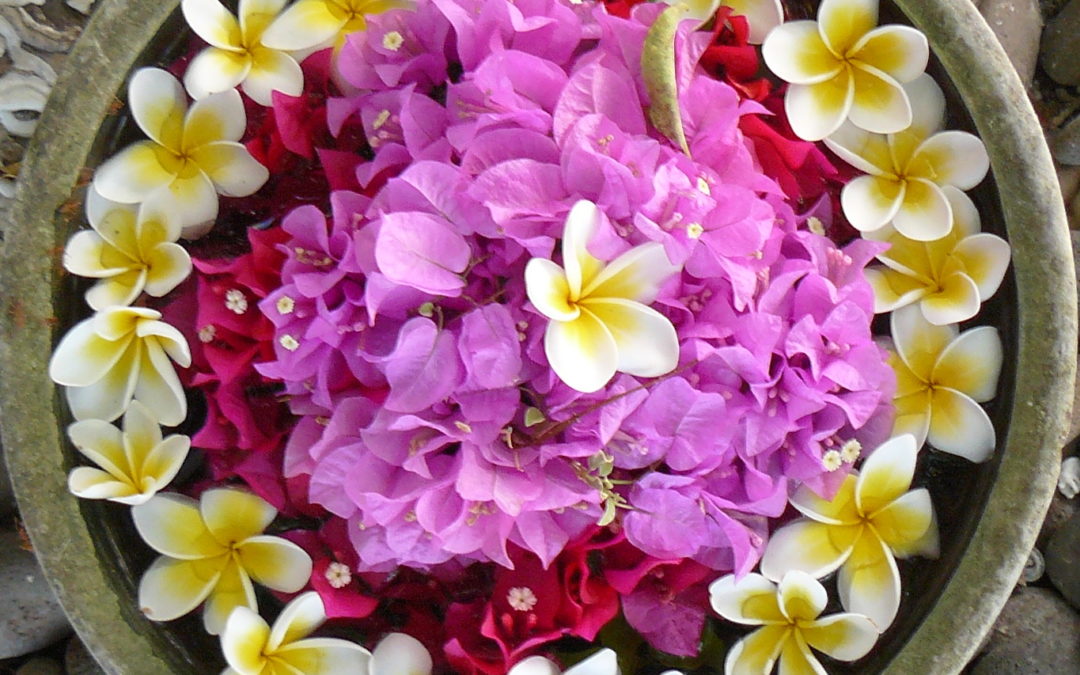While practicing and teaching yoga in Bali in 2009, I realized after a month or two that I was lonely in a new way. I did have a few friends and a wonderful roommate, but I was comparatively, now, spending more time alone. Access to modern modes of media communication – those wily transmitters like the Internet and the cellphone – were often dysfunctional and a scooter-ride away. For the first eight weeks, I basked in my freedom.
Yet, retiring each night to the singular option of going to our silent home after teaching yoga, I began to feel dismay. I would get on my scooter after class, and ride slowly to enjoy the soft pulse of the warm, moist night. Soon, however, I realized I was also riding slowly to avoid getting home. What was getting home? An anti-climax? A dead-end? The realization that I’m alone? Again?
It was easy to smell the coconut, lemongrass and curry from neighbors cooking together and to hear the distant clang-clang of the gamelan players rehearsing on our corner. Meanwhile, I’d spend another night pondering my life on paper in our sparsely furnished, womb-like home. My roommate and I would sometimes dine together, but when I taught yoga, I got back too late. During these early months, my thoughts built upon themselves, making comparisons as to what my life was not, creating universes of meaning.
If I paid attention to the sounds, smells, sights and textures of the natural landscape in Bali, it was obvious that I was anything but alone. In our Bali neighborhood, the surrounding animate world was moist, lush and one thousand shades of green. The rain thundered down, an army of pellets, the sweet smell of frangipani accosted our noses in simultaneity to the dank smell of river trash.
In relationship, I feel, to the quality of this natural landscape, devotion to the divine is palpable in Bali. The Balinese pursue a nearly constant activity of devotional ritual, be it through walking and chanting in white muslin clothing to honor the ancestors, or through putting out Prasad in carefully woven tea leaves for the spirits each morning. It was within this particular environment, and within my own surrendering process, that I was gifted with what was, for me, a realization.
Contemplating the root of my loneliness, I realized that a distinct life-view was causing me suffering. Quite often, no matter what I was doing – picking my way through washed up debris on the beach, driving my scooter through chaotic traffic, spending time with friends, participating in ceremony, or even while sipping a smoothie after yoga – I’d watch couples. I’d notice how they moved together, how their bodies swayed in tandem, how they laughed or fought. Rather than simply noticing them, I watched them through the gaze of a singular thought: without an intimate partner, a life is not complete. Thus, I was not complete. What singular thoughts are you holding onto that strengthen your suffering? How do you use what you see in the outer world to stoke the fire of these life-views?
Upon realizing that I was suffering due to my deep belief that a life-partner would make me complete, I also saw that lifetime partnership is a human story, rather than a fundamental, or universal story. Thus, it may or may not be my story.
I felt open. I considered that I might give myself to a life of service through symbolic (rather than sexual) celibacy or through partnership. It was not that I didn’t want partnership. I’d spent many a relationship looking, hoping, asking to be met, and, even being met for a duration. What happened in Bali – this capacity to let this human story go, as it might not be my story – was a gift that happened with me. I saw that I didn’t know what the story of my life would look like. I never fully will. Letting go of my long-held belief necessitated finding contentment in my state of being now. But how?
A shift in my awareness began with the flowers. In Bali, hundreds of frangipani flowers hung from trees planted along the perimeter of our house. Bright, magenta adenium grew skyward from large, rust-colored pots. Spines of vermilion heliconia bracts hung down at the back of the house next to a wall of bamboo, and an abundance of red torch ginger bloomed skyward behind the gate.
For several weeks, I got down on my knees before one of the flowering plants, and literally asked: “If human partnership is just one story, but not The Story, then how can this flower be like a lover? How do I receive through this living universe enough love to feel enlivened without a human partner?”
My teacher, Sofia Diaz, used to often say in class that, “the difference between whether you are doing yoga or doing gymnastics is the answer to the question: Are you in love?” In my early years of practice with Sofia, this sounded potent, and only slightly related to me. First, I took her question to be a reflection of my life, rather than a query into what I was feeling in the moment of a yoga pose. It took years to see this. Was I in love? I’d like to be. Was that good enough?
Day after day in Bali, I got down on my knees before all manner of flower and asked for help. “Hi,” I’d start out, whispering, “I love you. I’m grateful that you exist. Please help me to feel that this moment, noticing your beauty, is enough.” Sometimes, instead of asking, I’d tell the flower that noticing its particular beauty was enough. At night, I put my arms around myself under my bed sheet and repeated the phrase: I am held.
The shift from noticing the natural world with a hungry, mediocre attention to noticing the natural world and feeling filled by what is arising, even for a moment, was not an overnight process. Yet, the process did begin to happen. In moments, the heart-softening cotton-candy color of an adenium delighted me. A red hibiscus, in all of her fine, soft petaled-ness, spilled happiness into me. Intimate relationship was right here. Even now, in this library where I write this to you, I turn to the window to look at the green and orange oblong leaves of a thin tree blowing softly in the grey-day wind, and I feel better. My sore throat and the malaise that accompanies me on grey days are tolerable. These leaves are more alive than my thoughts.
I offer this practice to help you notice your relationship to immediacy and beauty in the natural world.
Noticing Practice
- Stop, and notice something in the animate world around you. If there is nothing in the animate world around you, notice that, and choose something that is in front of you to notice. What are the contours like? The texture? Color? How does it smell? How is it moving? (Not moving?) How does it change in the light? Can you keep your attention on the shifts in this thing, or is your mind wandering?
- How does this noticing make you feel?
- Slow down and take five deep breaths. Then, go through these same questions. How did the answers shift?
Taking moments out of everyday to notice the natural world, or what is happening around us and within our bodies, can help us to begin the process of softening, or moving our attention toward perceiving more than our thoughts. I’ll end with a quote by the Zen teacher, Charlotte Joko Beck:
Caught in the self-centered dream, only suffering; holding to self-centered thoughts, exactly the dream; each moment, life as it is, the only teacher; being just this moment, compassion’s way.


